► Tonale vs Evoque – the first test
► Can Alfa keep up with its posh rivals?
► Or is its beauty just skin deep?
Alfa Romeo enters the mid-size SUV style wars with the Tonale – a direct rival to the Evoque. But can it match the Brit’s proven practicality and performance? Time to find out.
Pre-flight briefing: Alfa Romeo Tonale
Why is it here?
Just look at it. Look. At. It. Do we really need any more reason than that? We haven’t seen an SUV as attractive as this since Evoque Mk1 broke the mould. But this is also our first chance to test the Tonale in the UK, following a somewhat traffic-choked launch event in Italy.
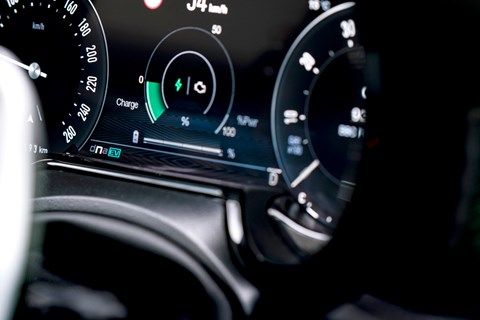
Any clever stuff?
Integrated Amazon Alexa isn’t new, but NFT-authenticated service records are. More immediately intriguing is the engine’s variable valve timing and turbo geometry, and the mild-hybrid system, which is able to move the Tonale on electric power alone – something starter-generator mild hybrids are usually unable to do. Neat, but less effective than those pesky self-charging Toyotas.
Which version is this?
The Veloce, which is an upgrade pack for the Ti model rather than a standalone trim. This nets you a minor bodykit, two-stage adaptive damping and those gorgeous Maserati-alike aluminium paddleshifters, among other items. You still have to pay extra for the 20-inch teledial wheels. Boo. There will also be an Edizione Speciale edition for early adopters. Mechanically, there are two main options: our mild hybrid, or the all-wheel-drive plug-in hybrid.
Pre-flight briefing: Range Rover Evoque
Why is it here?
The darling of dirt tracks, the starlet of suburbia, the Range Rover Evoque is as close to an icon as the mid-size SUV segment has, and the obvious foil to an exotic new Italian. It also offers a well-sorted driving experience.

Any clever stuff?
Stacks. The screens inside are a class apart to look at, but it’s the off-road prowess the Evoque brings to this segment that’s outstanding. Not so much a supermodel in wellies as an entire catwalk in crampons – if you need to cross a muddy field in style, this is your chariot.
Which version is this?
Hope you like a mouthful. This is a MY21 D200 MHEV AWD R-Dynamic SE, which loosely translates into a sporty-looking 2.0-litre Ingenium diesel four with mild-hybrid assistance, power-on-demand to all wheels and a middle-ranking equipment spec that’s actually still huge. Be wary of the options list – the test car is nearly 52 grand. The range starts at £34,010, which gets you a front-wheel-drive diesel, and peaks at £58,015 for a plug-in hybrid in Autobiography trim. There are also two mild-hybrid diesels (a less powerful one as well as our test car) and a brace of mild-hybrid petrols, with eight spec levels.
The Forza awakens: Tonale vs Evoque
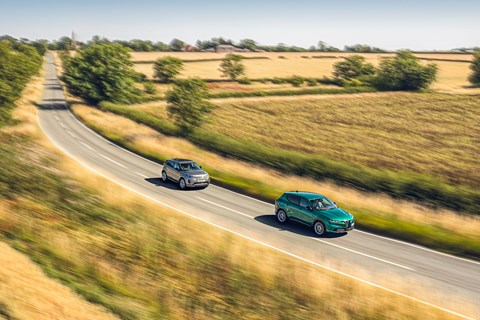
heck out the tyres. A small detail, perhaps, but one that makes Alfa Romeo’s intentions clear. The Tonale – Alfa’s first mid-size crossover and only its second SUV, after the Stelvio – is fitted with P-Zeros, from Pirelli’s ‘ultra high-performance’ range of rubber. Who cares about cross country when you could be going flat out?
The Range Rover Evoque, by contrast, comes on SUV-optimised Pirelli Scorpion tyres. It’s part of the Land Rover family, so of course you can take it off-road, with Terrain Response 2 and All-Terrain Progress Control present and correct to help you out.
All of which may be utterly irrelevant, because if the Tonale sells well that will be down to its looks. If you’re not getting this from the pictures, wait until you see one in the metal. It is extraordinary. We haven’t driven an SUV that turns heads this much since the original Evoque – which still looks very sharp. From a distance, you’d be hard-pressed to tell the difference between this second-generation Evoque and the original, and you can see why JLR didn’t change much.
The Alfa’s sporty vibes continue inside, with the Tonale’s digital instrument cluster housed in a double-bubble binnacle. The cockpit is most positively described as cosy for the driver. Plus points include plenty of physical buttons, a definite sense of occasion and an intuitive logic to the control layout, including integrated Amazon Alexa.
In the Range Rover, the clean lines and fancy twin central screens establish a sense of premium class and airy spaciousness the Alfa lacks, even if the absence of buttons inevitably increases the complexity of processes such as adjusting the fan speed. And it’s more cramped in the back than the Alfa.
The Tonale range will be topped by a 271bhp Q4 model with plug-in hybrid power, but for now we must make do with front-wheel drive and a fiendishly complex 158bhp mild-hybrid set-up. Where our diesel Evoque is only able to use its mild-hybrid starter-generator system to recover energy and provide barely perceptible assistance to the engine, the Tonale can unusually deploy its 20bhp electric motor to move the car on its own, if only for brief moments. Combined with a new high-compression 1.5-litre petrol engine with dual variable valve timing, variable-geometry turbocharger, 350-bar direct injection and the fuel-efficient Miller cycle, there’s a lot going on.
While, yes, 158bhp means the Tonale is significantly outgunned by the 201bhp provided by this popular Evoque diesel engine, the Italian is over 300kg lighter than the Range Rover. Thus, the official 0-62mph times are only 0.3sec apart, the Evoque’s 8.5sec sprint taking the lead. In real life, the difference is more palpable, as the Alfa is absolutely walloped for torque – the Tonale mustering just 177lb ft to the Evoque’s 317, which it gets more flexibility to deploy thanks to the nine-speed automatic transmission, against the Alfa’s seven.
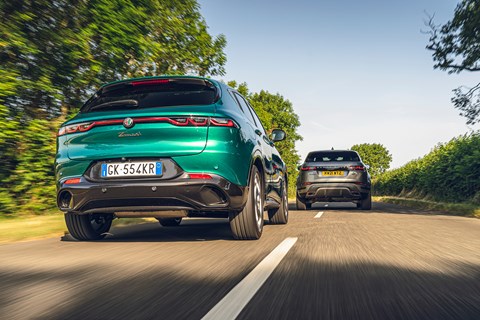
Neither vehicle feels fast in isolation. But driven back-to-back, the Evoque is far punchier, with a surging thwock of muscularity accompanying every upshift, sometimes a touch too abruptly. Leather the Alfa and it’s smooth enough, with a reasonably sporty exhaust note for a tiddly inline four, but you do have to make full use of the pedal’s travel. In the Range Rover you can just surf the torque, occasionally remembering to be impressed by how well isolated the engine is, as only the faintest of under-bonnet vibrations ever reach the cabin. Diesel suits the laid-back nature of this mobile fashion icon. Shame we never saw higher than 33mpg during the test. The fact that the Evoque’s economy figure was beaten by a petrol car might suggest that the Tonale’s mild-hybrid system is pretty well sorted – except the Alfa’s figure of 35mpg is hardly brilliant.
If the Tonale’s powertrain has a problem, it’s not pace or economy, it’s over-complexity. At anything less than full pelt it feels like it’s in constant disagreement with itself, as if once the development team had established just how quickly they could get the Tonale to lap the Balocco test track they lost interest in finessing it further. From the stuttering pulsing at walking speed to the lottery that is pulling into traffic, when you’re never quite sure exactly how much response you’re going to get, the impression is very much of something incomplete. Switching into Dynamic mode helps – it’s more decisive than Normal, while the torque-capping Advanced Efficiency setting is best left to masochists – but it all seems rather Beta Romeo.
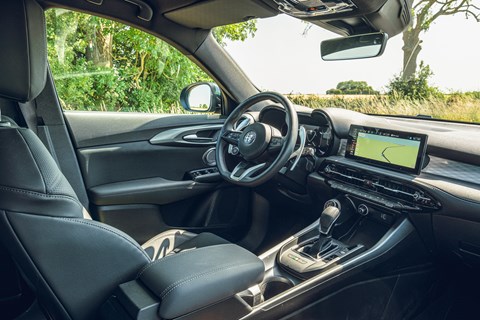
This is an early car, so you’d hope that cars delivered to actual paying customers later in the year will be better sorted. Of course it makes sense to maximise efficiency by activating the EV capability as much as possible, but the way the Tonale flickers between motive forces comes across as borderline schizophrenic. And while the theory of the combustion engine having the ability to mess with its valve timing and its turbo geometry may be good, the execution needs to be better than this.
When so little in the powertrain functions in a fixed manner, this Tonale is a rolling demonstration of just how thorough and comprehensive that calibration process needs to be. Heaven forbid you add your own inputs into the mix by taking manual control of the gearbox, as this additional confusion just seems to cause the car to trip over itself even more. Which is a shame, since the oversized arcs of the column-mounted paddleshifters are as temptingly tactile to use as they are beautiful to look at.
It’s not quite tear-your-own-hair-out irritating (in this instance, that facet of Alfa-ness is fulfilled by the continuously squeaking seat-belt retainer, right by the driver’s ear, which we’ll generously put down to a pre-production issue), but even a short trip around town can become an exercise in frustration management.
The Evoque’s less ambitious engine arrangement makes for more relaxed urban progress and greater consistency, relying on that diesel torque. That said, for such an established product it is surprisingly easy to catch out the Range Rover’s gearbox, especially as you begin to go faster. It’s a peril of having so many ratios that’s eased by using Sport mode when appropriate.
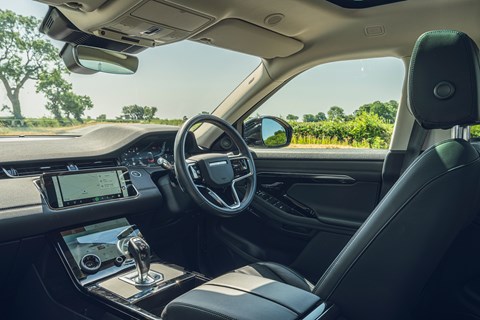
The Evoque’s comfort is also less than optimal. The seats are fine, but it bumps and batters its way over bad surfaces. Both test cars are fitted with two-stage adaptive suspension – and 20-inch alloys, don’t forget – but if you’re tempted to use the harder setting in either one for extended periods your back is clearly in better shape than mine. I can’t quite decide which is actually worse for ride comfort, generally, as both seem determined to pick a fight with the tarmac – and if the Range Rover pulls its punches a little earlier, it’s more beset with shudders and lurches. As such, I feel I can better forgive the Tonale’s fidgety firmness for its flatter cornering stance and impressive ability to regain composure after being unsettled.
The Alfa is certainly the more ‘dynamic’ of the two. It has a smaller steering wheel and a super-direct 13:6 steering ratio that’s immediately reactive off-centre, something you notice most under braking, when the Tonale has a tendency to squirm about unless you keep an iron grip. Those brakes have a sharper bite compared with the Evoque’s rather soft left pedal, too, but the way the retardation source is varied between friction and regen means they can be difficult to modulate.
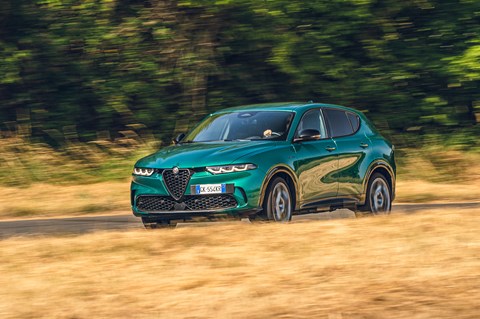
Worse, for all that the Alfa is ultimately more precise, the steering gives very little feedback at rational speeds. Whatever tuning’s been done on the electric assistance seems committed to a consistency that would have been better applied to the powertrain. So, while torque vectoring by brake and that fine body control enable rapid-fire direction changes and big cornering velocities, you get no sense at all of the forces building thorough the steering, and no real incentive to engage with the process.
This might be fine at maximum attack on a test track; on the road I’d like more dialogue. This is an SUV, not a single-seater, after all. The Evoque’s steering wheel may seem comparatively bus-like, and its responses sloppier, but the process of driving it feels more authentic. Again, there’s artificial torque vectoring, and the all-wheel drive means traction is rarely a concern, yet the messages you get in the driver’s seat are less filtered and still neatly judged.
I’d have no hesitation about going on a lengthy motorway journey in either model, which is probably of greater significance to the target audience. Fundamentally, they both do a grand job of riding high and looking good, and maybe that’s all that really matters.
Tonale vs Evoque: the final reckoning
They say fabulous looks can compensate for a multitude of sins. But have Alfa Romeo’s stylists done enough with the Tonale to knock the Evoque off its perch as the go-to SUV to be seen in? While there is something remarkably timeless about the Range Rover’s appearance, it’s also now thoroughly familiar. It won’t set eyeballs swivelling the way that it used to, even if its pedigree is unquestionably established.
So, if making a scene is your priority, the Tonale is your winner here. Phil McNamara described its visual impact outside and in as a breath of fresh air in a staid segment during our initial encounter. If anything seeing this new Alfa mixing it with contemporary UK traffic only enhances this impression. It’s a triumph of surfacing and attitude that, like the Evoque, manages to stand out sharply against the more conservative opposition without any obscene compromises in practicality. That said, you can tell style was the primary decision maker for the exterior by the rear doors – with a window line that’s explicitly intended to echo the 8C Competizione, there’s an unexpectedly jutting piece of glass that nearly chinned me every single time I opened them.
In this contest between petrol and diesel MHEVs, the Alfa’s list price offers a saving of £6000. But you can get less expensive Evoques, and every version is enormously well equipped. What’s more, once you get into monthly payments, on similar terms the Range Rover comes out slightly cheaper. Thank the solid residuals of a much-loved and in-demand product.
Perhaps surprisingly, given that it’s a new-for-2022 model, the Tonale has the more user-friendly interior – with actual buttons! – but the Evoque’s exudes modernity, spaciousness and higher class. It feels like a more premium product.
That leaves us with the driving experience – which is troubling for both parties. Why isn’t the Evoque, after JLR’s had so long to perfect it, more comfortable? And why isn’t the Tonale, given Alfa’s fine heritage, more dynamically engaging? Incisive and capable though it clearly is, the lack of feedback through the steering is numbing, and the electrically assisted complexity of the engine is crying out for further refinement. If Alfa could only get it to act like a single entity, rather than several, this would be a much more convincing machine.
As such, though it breaks my heart to reject something so beautiful, our winner here is the Evoque. There’s still a place for a decent dose of diesel, and overall it’s a much more complete experience – just maybe consider downsizing the wheels.

Tonale vs Evoque: the verdict
First place
Range Rover Evoque
Far from perfect, but still a fine package after all this time
Second place
Alfa Romeo Tonale
Can’t quite deliver on the promise of the great looks